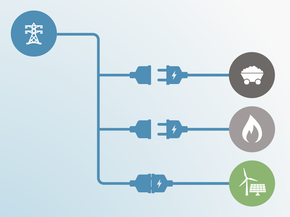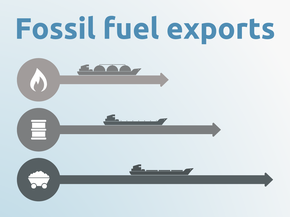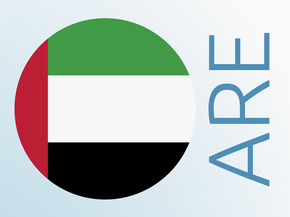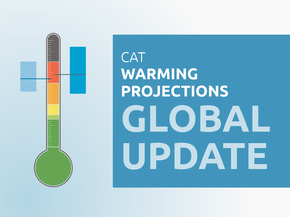Critically Insufficient4°C+
World
NDCs with this rating fall well outside of a country’s “fair share” range and are not at all consistent with holding warming to below 2°C let alone with the Paris Agreement’s stronger 1.5°C limit. If all government NDCs were in this range, warming would exceed 4°C.
Highly insufficient< 4°C
World
NDCs with this rating fall outside of a country’s “fair share” range and are not at all consistent with holding warming to below 2°C let alone with the Paris Agreement’s stronger 1.5°C limit. If all government NDCs were in this range, warming would reach between 3°C and 4°C.
Insufficient< 3°C
World
NDCs with this rating are in the least stringent part of a country’s “fair share” range and not consistent with holding warming below 2°C let alone with the Paris Agreement’s stronger 1.5°C limit. If all government NDCs were in this range, warming would reach over 2°C and up to 3°C.
2°C Compatible< 2°C
World
NDCs with this rating are consistent with the 2009 Copenhagen 2°C goal and therefore fall within a country’s “fair share” range, but are not fully consistent with the Paris Agreement long term temperature goal. If all government NDCs were in this range, warming could be held below, but not well below, 2°C and still be too high to be consistent with the Paris Agreement 1.5°C limit.
1.5°C Paris Agreement Compatible< 1.5°C
World
This rating indicates that a government’s NDCs in the most stringent part of its “fair share” range: it is consistent with the Paris Agreement’s 1.5°C limit.
Role model<< 1.5°C
World
This rating indicates that a government’s NDC is more ambitious than what is considered a “fair” contribution: it is more than consistent with the Paris Agreement’s 1.5°C limit.
Sources
List of references
- Bloomberg. (2015). U.A.E. Removes Fuel Subsidy as Oil Drop Hurts Arab Economies.
- Electricity insight | Ministry of Economic Development. (n.d.).
- Etihad ESCO. (2014). About Etihad ESCO. Retrieved from http://www.etihadesco.ae/about-etihad-esco/index.html
- European Commission Joint Research Centre (JRC)/Netherlands Environmental Assessment Agency (PBL). (2013). Emission Database for Global Atmospheric Research (EDGAR), release EDGARv4.2 FT2010.
- IEA. (2015). World Energy Outlook 2015. Paris, France: International Energy Agency.
- IEA. (2016a). CO2 Emissions from Fuel Combustion.
- IEA. (2016b). Energy Statistics and Balances. Paris, France.
- IPCC. (2018). Global Warming of 1.5°C. Summary for Policymakers. Retrieved from http://report.ipcc.ch/sr15/pdf/sr15_spm_final.pdf
- Kuramochi, T., Höhne, N., Schaeffer, M., Cantzler, J., Deng, Y., Sterl, S., … Deryng, D. (2017). Ten key short-term sectoral benchmarks to limit warming to 1 . 5 ° C, 3062(December). https://doi.org/10.1080/14693062.2017.1397495
- Masdar Institute/IRENA. (2015). Renewable Energy Prospects: United Arab Emirates. REmap 2030 analysis. Abu Dhabi.
- Merrill, L., Bassi, A. M., Bridle, R., & Christensen, L. T. (2015). Tackling Fossil Fuel Subsidies and Climate Change: Levelling the energy playing field. https://doi.org/http://dx.doi.org/10.6027/TN2015-575
- Ministry of Energy. (2012). Third National Communication of the United Arab Emirates, (December), 1–7.
- Ministry of Energy. (2015a). The UAE State of Energy Report.
- Ministry of Energy, U. A. E. (2015b). Fuel Prices to be Regulated with effect from 1 August, 2015.
- Ministry of Energy, U. A. E. (2015c). UAE State of Energy Report 2015.
- MOCCAE. (2017). National Climate Change Plan of the United Arab Emirates 2017-2050. Retrieved from https://www.moccae.gov.ae/assets/30e58e2e/national-climate-change-plan-for-the-united-arab-emirates-2017-2050.aspx
- The National. (2015). UAE’s environment goals set out ahead of crucial Paris conference. Retrieved from https://www.thenational.ae/uae/environment/uae-s-environment-goals-set-out-ahead-of-crucial-paris-conference-1.70904
- UAE Government. (2018). The Official Portal of the UAE Government. Retrieved from https://government.ae/en/information-and-services/environment-and-energy/electricity.
- US EPA. (2012). Global Anthropogenic Non-CO2 Greenhouse Gas Emissions: 1990 - 2030.
- WAM. (2017). President of Masdar: the strategy of the UAE leads to a sustainable use of energy resources.
Further analysis
Latest publications
Stay informed
Subscribe to our newsletter







